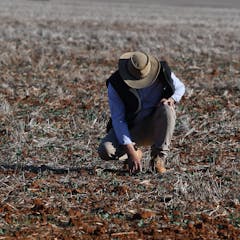
Artikel-artikel mengenai Melbourne
Menampilkan 1 - 20 dari 241 artikel

Rising has great potential to transform the arts ecosystem in Melbourne. But this requires some deep consultation and consideration as it contemplates what the future holds.

Sydney emerges as the most segregated of our biggest capital cities, and the trend will continue without broad changes in government policy and investment.

Edwina Preston approaches Nova Weetman’s ‘generous and open’ grief memoir from a place of shared loss.

Recent flash droughts in parts of NSW and Victoria appeared quickly and can be followed by intense flooding rains. It’s part of a global trend driven by global warming.

Despite adopting the goal of creating medium-density neighbourhoods to end urban sprawl, our cities have struggled to achieve it. Confused debates about ‘good density’ are part of the problem.

A mysterious hunk of space junk buzzed through Australian skies last night. It may have been the third stage of a Soyuz 2 rocket just launched by Russia.

A new survey found sexual violence disempowers female music workers, deters non-binary communities from working in the industry, and discourages punters from going to gigs.

Tara Calaby’s novel peeps into the interior lives of women in a 19th-century asylum and uses her historical imagination to generate new knowledge.

The successful quest to find a species last seen more than 50 years ago has added to the urgency of protecting the vanishing grassland habitat of a lizard that had been feared extinct.

Eliza Batman has remained largely a footnote to her husband, whose dark deeds in the war over land are now well-known. How should we remember her today?

The Andrews government has made a decent first step to reduce Victoria’s mountain of debt by $30 billion over the next decade.

The Hoddle Grid that dictates the flow of vehicles and people in central Melbourne has had its day. It can be remade to reduce the dominance of cars and create a liveable city for the 21st century.

Foods stir up river sediments and can spread contaminants across the floodplain. It’s a risk in areas with a history of industrial pollution, like Maribyrnong, but EPA test results are reassuring.

After Anita Lane died, former collaborator Nick Cave said she “despised the concept of the muse but was everybody’s”. Meera Atkinson highlights her achievements – with help from those who knew her.

A survey of more than 2,000 people as Melbourne reopened after COVID lockdowns shows the pandemic and digital technology have made the city less a place of work, more a place to visit now and then.

Jay Carmichael’s novel explores how Australian same-sex attracted men lived during the repressive period after the end of the second world war. But does it impose present concerns on the past?

Ken Cameron’s film of Helen Garner’s Monkey Grip is dark, yearning, weird – and incredibly sexy – writes Ronnie Scott.

Lead levels in backyard hen eggs are often much higher than in eggs bought in the shops. A new study of soil lead, chickens and eggs locates the high-risk areas in our biggest cities.

In a country that has largely avoided political and cultural hyper-partisanship, the Barassi Line is perhaps our strongest sociographic dividing characteristic, and certainly novel globally.

Image recognition algorithms, military satellites, and mobile data networks can all help estimate crowd sizes. But the underlying maths still comes down to a basic formula: density multiplied by area.
